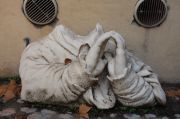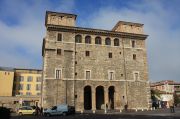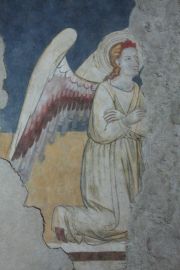Terni is an very strategically important town along via Flaminia, both historically and presently. And it runs as the heart of Italy both geographically and economically. I believe it will continue to serve italy as what it has done in the past.
|
 |
 |
 |
 |
 |
 |
 |
 |
Abandoned Statute in Terni
 |
 |
Terni has an very ancient Roman name, Interamna, meaning " in between two rivers", which explictly articulates its old history as well as its strategic location. It was founded probably in the 7th century BC and conquered by the Romans in the 3rd century BC. It had witnessed its prosperity during the Roman Empire, serving an important municipium lying on the via Flaminia. It was in this period that many great architures, such as aqueducts, walls, amphitheaters, temples and bridges, were built. But this bright history ended soon with the advent of the Lombard conquest in 755 and then the invasion of Frederick Barbarossa in 1174. It lost its prominence in Umbria, and became a secondary town in the Duchy of Spoleto.
Terni has won a pretty modern nickname, Manchester of Italy for its industrial tradition. But this tradition could be dated even back to the ironwork in 1580, mining the iron ore in the nearby monteleone di Spoleto and making iron from it. But the real industrial development came with the Industrial Revolution in the 19th century, many new industries, such as steelwork, weapons, jute and wool industries, chose Terni as their bases because of its large water resources. But dark history came again. In the Second World war Terni bore the brunt of the war and became the favorite target for the Allied bombardments for its strong industries. Many historic buildings were destroyed at that time.
The vicissitude of life does not change Terni very much. Today what I can see is a still quite vigorous and confident Terni. This vigor and confidence run out of its strategical geography as well as the bounduant endowments. But I can give you pretty new explanation. Chinese says Feng Shui, many of you must hear something about it. It is a long story, but a place with a good Feng Shui must has at least water and moutain, Terni has both of them.
|
|
| Favourite spots: |
Terni is quite ancient but also pretty young. It has a historic center, which hosts almost all medieval buildings. But the town itself was rebuilt on the ruins of the Second World War, and thus it boasts of numerous modern architures. I see Terni as a perfect example how modern development can be well incorporated into historical creation. Therefore if my travel report on Terni only told you the historical sites, it would be unfair for Terni, and you would not have a complete picture of Terni, either. I would like to split my report on favorite sites into two parts: historical sites and modern architures.
1. Historical Sites
I use the tricks introduced in my general report on Via Flaminia for how ot examine the elegancy of Italian towns. Just look at their two image projects, church and municipal building, which are usually located at one main square. Not all the italian towns had amphitheater, but they had, they would definitely be put at a different star level. [Continue]
|
|
| What's really great: |
Amphitheatre is used by me as the extra criterion for ranking the italian towns. Terni has an amphitheatre, called Anfiteatro Fausto. It is the most ancient existence in the town. The information I got from Wikipedia said it was built in 32 BC, around the same age of the Colosseum of Rome, and could be capable of 10,000 spectators. But Terni has its own story that it was built in 20 BC and the capacity was 12,000. That what I was told by a nice lady who was selling ticket, meanwhile working as a tour guide. The amphitheater still keeps the most part of its original wall, and it also has very nice small church. But all the stairs are gone, which make the amphitheatre look like an encircled space. The price is 4.5 Euro, including the entrance to the archeoogical museum of the town as well as to the Pinacoteca Comunale. Quite economical, isn't it?
Terni does not have the same squares as other italian towns, which put the municipal building and the cathedral togehter.
[Continue]
|
|
| Sights: |
 |
 |
 |
 |
 |
 |
 |
 |
Palazzo Spada, the current town hall of Terni
 |
 |
The cathedral of Terni is just sitting back to back with the amphitheatre. It is an very impressive facade and a pretty high bell tower. But according to the wikipedia, the profile of a sabot one used to measure the citizen's shoes in one of two mediaeval gates is more interesting. I did not know that before, but I did find them quite special and took some pictures. The interior of the duomo is also wonderful, but I like the big fresco on the counter-facade wall. I did not understand what story it was trying to tell, but I thought it was about life and death.
Terni has two town halls, the former one and the current one. The current one is called Palazzo Spada, the former is called ex palazzo Comunale, now it is changed into a library. Both of the two buildings are quite impressive, but the interesting thing is that the former town hown looks even pretty newer than the Palazzo Spada.
|
|
| Accommodations: |
 |
 |
 |
 |
 |
 |
 |
 |
Fresco in Church of San Peter
 |
 |
Terni boasts of nice churches, San Alo, San Pietro, San Salvatore, San Cristoforo, Basilica di San Valentino, just to name a few.
(1) San Pietro
The picture that you see in this section is the fresco taken in the Church of San Pietro. It is a pity that the Wikipedia's story on Terni has nothing about it at all. It is probably the biggest church, because I am not quite San Pietro and the Duomo which one is bigger. The facade of San Pietro is not as attractive as the Duomo, but it has great frescoes that the Duomo does not possess.
(2) San Alo
Located in the vicinity of the Duomo, San Alo does has its own special thing. The four lion statues are quite eyes-catching. Two of them are sitting at each side of the entrance, so ancient that the heads of them are missing. The other two are hung on the walls to the left of entrance.
(3) San Lorenzo
It has a plain facade, but the interior is quite interesting, particularly in terms of architecture. Be careful of the stairs.
[continue]
|
|
| Nightlife: |
(4) Basilica di San Valentino
Standing out of the town, the Basilica is a little bit far from the center, and it is not even in the map of the city. But it does deserve your visit. It has an very impressive facade, very much like the Duomo. There are some nice relieves on the gate, the most funny thing is that someone died the golden rose in the hand of the Pope into red, making the Pope like the man in Valentine Day. Full of Italian's sense of humor and romance, I love it.
There are another church, San Franceso, that you can not afford to miss. It is located in a quite spacious square, has some caffe and bars around the corner. But when I got there it was closed, I did not get a chance to have a look inside.
The picture that you see in this part is a small Roman gate called Porta Sant'angelo. It is one of the four ancient entrances to the city. It is at the end of one of the main street, via Corso, and in the vicinity of San Francesco. It is very impressive in the sunset.
|
|
| Hangouts: |
2. Modern Architecture
Terni is also a good place to see the modern architecture of Italy. (1) Lancia di Luce
The picture shown here is called Lancia di luce ( Lance or Spear of Light). It is out of the hands of the famed contemprary Sculptor Arnaldo Pomodoro, whose works can also be found in Tokyo, New York, Mosco, Los Angles, Dublin.
The story that the monument is trying to explain is really like Terni's own story. The height of oblisk represents the technical results that Terni as well as the whole civilization has achieved, from the raw iron at its very base to the shine of light at the highest end. Meanwhile it is trying to stimulate us to think over another question that perplex our human beings for centuries, that is what development and civiliazation are for? Terni's own development and historical fate give us an very vivid lesson.
[continue]
|
|
| Restaurants: |
(2) Grande Pressa
This picture used to serving another postcard image of Terni. It is called Grande Pressa, just located in a square before the train station. It is the machine that was used for military purposes first, forging amore plates and gun for the army and navy, later changed for economical purposes, producing alloy steel for the manufactures around the world. It stoped serving Terni as well as Italy in 1993. The monument says this machine has relevant place in the history of technology, and its preservation is an important mark in industrial archaeology and reliable evidence of the skill of the people in Terni.
What Terni really impressed me was something more than this huge giant. I found many people in Terni speaking english, and they liked to do that. You might nothing new, but my three year experience told me instinctly this was a great discovery and I had to put it my report. Technology and industry mean development, and development means new change.
[continue]
|
|
| Other recommendations: |
Only those who are brave to try new things do stand as the spearhead of the development. What I saw in Rome as well as the other major cities in Italy are people refusing to learn or speak English. You can not imagine how difficult life here if you can not speak Italian. It does not mean Italians are not endowed with privileges for learning or speaking foreign languages, they are just lazy to do that. But Terni tells me a different story. They have vast resources that any development has to rely on, but they are working and ready to learn, that's why I see the future of Terni full of hope, at least in Italy.
Back to my Chinese Fengshui Story, a good Fengshui nourishes excellent people. Terni is such a place. Many great people came from Terni, and the most famous could be the Roman emperor Tacitus. The picture that you see is another great modern creation, a fountain built on the square named after him, Piazza Tacito.
|
|
Published on Monday December 8th, 2008
|
|
 Publish on Facebook
Publish on Facebook
|
Fri, Jan 02 2009 - 10:47 AM
 by davidx
| Good stuff. I changed trains at Terni en route from L'Aquila to Spoleto. I'm quite glad I didn't know what I was missing or I might not have reached Spoleto!! |
Thu, Dec 11 2008 - 04:10 AM
 by robynallen by robynallen
| This report was very informative and you have conveyed your self in a manner easily understood. The picutes are great too. |
Tue, Dec 09 2008 - 04:45 AM
 by jorgesanchez by jorgesanchez
| Good complement to your previous reports! |
Mon, Dec 08 2008 - 05:46 PM
 by pesu by pesu
| Very informative report, Yuliang. Interesting to read your opinion about Feng Shui and the connection between development and using foreign languages. :) |
| Information: |
| Login if you are a member, or sign up for a free membership to rate this report and to earn globo points! |
|
| Italy |
|
|
|
|
|
|
|
|
|
|
|
|
|
|
|
|
 |
| Spain |
|
|
|
|
|

|
